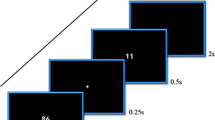Abstract
Mental computation helps children understand how numbers work, how to make decisions about procedures, and how to create different strategies to solve math problems. Although researchers agree on the importance of mental computation skills, they debate how to help students develop these skills. The present study explored the existing literature in order to identify key points that are related to students’ use of different mental calculation strategies in a variety of settings and their conceptual understanding of those strategies.
Similar content being viewed by others
References
Blote, A. W., Klein, A. S., & Beishuizen M. (2000). Mental computation and conceptual understanding. Learning and Instruction, 10, 221–247
Carpenter, T. P., Coburn, T. G., Reys, R. E., & Wilson, J. W. (1976) Notes from National Assesssment: Estimation. Arithmetic Teacher, 23, 296–302
Carpenter, T. P., Franke, M. L., Jacobs, V. R., Fennema, E., & Empson, S. B. (1998). A longitudinal study of invention and understanding in children’s multidigit addition and subtraction. Journal for Research in Mathematics Education, 29, 3–20
Cobb, P., & Merkel, G. (1989). Thinking strategies: Teaching arithmetic through problem solving. In: P. Trafton & A. Shulte (Eds.), New directions for elementary school mathematics (pp. 70–81). Reston, VA: National Council of Teachers of Mathematics
Cooper, T., Heirdsfield, A., & Irons, C. (1996). Children’s mental strategies for addition and subtraction word problems. In: J. Mulligan & M. Mitchelmore (Eds.), Children’s number learning (pp. 147–162). Adelaide: Australian Association of Mathematics Teachers, Inc
Heirdsfield, A. N. (2000). Mental computation: Is it more than mental architecture? Paper presented at Annual Meeting of the Australian Association for Research in Education, Sydney. Retrieved November, 12, 2006 from http://www.aare.edu.au/00pap/hei00259. htm
Heirdsfield, A. N., & Cooper, T. J. (2004a). Factors affecting the process of proficient mental addition and subtraction: Case studies of flexible and inflexible computers. Journal of Mathematical Behavior, 23, 443–463
Heirdsfield, A. N., & Cooper, T. J. (2004b). Inaccurate mental addition and subtraction: Causes and compensation. Focus on Learning Problems in Mathematics, 26(3), 43–66
Hiebert, J., & Wearne, D. (1996). Instruction, understanding, and skill in multidigit addition and subtraction. Cognition and Instruction, 14(3), 251–283
Kamii, C., Lewis, B., & Jones, S. (1991). Reform in primary education: A constructivist view. Educational Horizons, 70, 19–26
Kamii, C., Lewis, B., & Livingston, S. J. (1993). Primary arithmetic: Children inventing their own procedures. The Arithmetic Teacher, 41(4), 200–2003
Klein, T., & Beishuizen, M. (1994). Assessment of flexibility in mental arithmetic. In J. E. H. Van Luit (Ed.) Research on learning and instruction in kindergarten and primary school (pp. 125–152). Doetinchem, the Netherlands: Graviatt Publishing Company
Klein, A. S., Beishuizen, M., & Treffers, A. (1998). The empty number line in Dutch second grades: Realistic versus gradual program design. Journal for Research in Mathematics Education, 29(4), 443–465
Lucangeli, D., Tressoldi, P. E., Bendotti, M., Bonanomi, M., & Siegel, L. S. (2003). Effective strategies for mental and written arithmetic calculation from the third to the fifth grade. Educational Psychology, 23(5), 507–520
Maclellan, E. (2001). Mental calculation: Its place in the development of numeracy. Westminster Studies in Education, 24(2), 145–154
McIntosh, A. J., Reys, B. J., & Reys, R. E. (1992). A proposed framework for examining number sense. For the Learning of Mathematics, 12(3), 2–8
National Assessment of Educational Progress (2005). The nation’s report card. Retrieved December 10, 2006 from http://nces.ed.gov/nationsreportcard
Reys, B. J. (1985). Mental computation. Arithmetic Teacher, 32(6), 43–46
Reys, R. E. (1984). Mental computation and estimation: Past, present, and future. The Elementary School Journal, 84(5), 546–557
Siegler, R. S., & Campbell, J. (1989). Individual differences in children’s strategy choices. In P. L. Ackerman, R. J. Sternberg, & R. Glaser (Eds.), Learning and individual differences: advances in theory and research (pp. 218–254). New York: Freeman
Sowder, J. T. (1992). Making sense of numbers in school mathematics. In G. Leinhardt, R. Putman, & R. Hattrup (Eds.), Analysis of arithmetic for mathematics teaching (pp. 1–51). Hillsdale, NJ: Lawrence Erlbaum Associates
Sowder, J. T. (1994). Cognitive and metacognitive processes in mental computation and computational estimation. In R. Reys, N. Nohda (Eds.), Computational alternatives for the twenty-first century (pp. 139–146). Reston, VA: NCTM
Thompson, I., Smith, F. (1999). Mental calculation strategies for the addition and subtraction of 2-digit numbers. Final report. University of Newcastle, Newcastle upon Tyne
Varol, F., & Farran, D. (2006). Early Mathematical Growth: How to support young children’s mathematical development. Early Childhood Education Journal, 33(6):381–387
Author information
Authors and Affiliations
Corresponding author
Rights and permissions
About this article
Cite this article
Varol, F., Farran, D. Elementary School Students’ Mental Computation Proficiencies. Early Childhood Educ J 35, 89–94 (2007). https://doi.org/10.1007/s10643-007-0173-8
Received:
Accepted:
Published:
Issue Date:
DOI: https://doi.org/10.1007/s10643-007-0173-8




